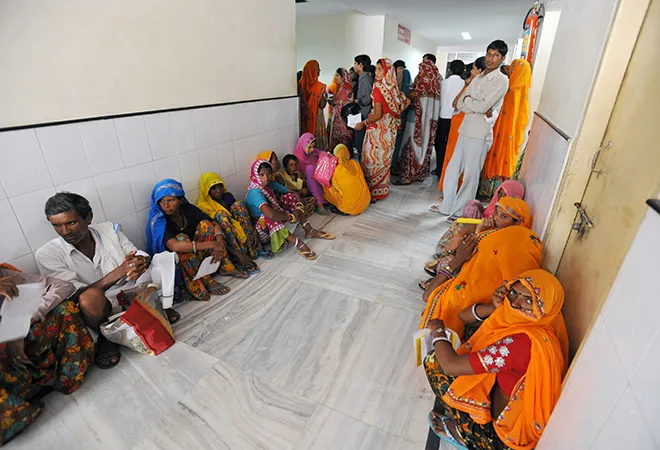
People may find it shocking that India has slipped from the 130th rank to 131st among the 188 countries on the human development index according to the latest UNDP’s Human Development Report (2016). Norway has the first position. Should this surprise us? Yes, because India’s latest GDP growth rate is an astounding 7.1 per cent in the last quarter despite the demonetisation woes and its consequent economic disruptions. India is among the fastest growing countries in the world and has climbed up in the Ease of Doing Business Index by four notches in 2016. Clearly something is wrong somewhere. While India is surging ahead in terms of GDP growth, it is faring poorly on the human development front which means that millions of Indians have less healthcare and education than in more advanced countries or even in Emerging Economies like the BRICS where India’s rank is the lowest. China’s rank is at 90th, Brazil 79th, Russia 49th and South Africa 119th.
Even among SAARC members, India’s Human Development Index( HDI) rank is lower than Sri Lanka and Maldives and a little higher than Bhutan, Bangladesh, Pakistan, Afghanistan and Nepal. India, however, has graduated from the low human development category to the medium category. While this is impressive, it cannot compensate for the ignominy of slipping when ranked according to the HDI index, when it is shining otherwise in terms of several business indicators.
Begun in 1990, the HDI, calculated by the UNDP, is an average measure of basic human development achievements of a country. It ranks countries into four tiers of human development on the basis of indicators of life expectancy, education and per capita income. Thus higher life , level of education and higher GDP per capita results in a country scoring higher HDI.
But HDI masks inequality in the distribution of human development across the population of a country. The loss in human development due to regional inequality is expressed by the difference between the HDI and inequality adjusted HDI or IHDI. As inequality increases, loss to human development also increases. Hence India’s HDI score for 2015 is 0.624 but if it accounts for inequality it falls to 0.454, a loss of 27.2 per cent. For medium range HDI countries the average loss due to inequality is 25.7 per cent but for South Asia as a whole it is 27.7 per cent.
In a hugely patriarchal country like India, one cannot expect India to score high on gender equality. India Gender Development Index is not surprisingly lower than the average at 0.810. Switzerland is number 1 with Gender Inequality Index at 0.040. South Asia’s gender development index is in any case the lowest in the world. India’s maternal mortality ratio remains high 174 per 10,000 live births (2015). Switzerland’s IMR is only 5. India’s aim was to reach 140, which also was the Millennium Development Goal by 2016. But it couldn’t. Women’s empowerment in terms of mean number of years of schooling is only 4.8 years compared to 8.2 years for males. Income per capita for females per year was $2184 (in terms of 2011 Purchasing Power Parity) and $ 8897 for males. Labour force participation is at 26.8 per cent only and Parliamentary seats occupied by women only at 12.2 per cent, which is lower than the average for developing countries.
India has shown an improvement in overall life expectancy by 10.4 years between 1990 and 2015 and there has been a modest gain in infant and under 5 mortality rate. But when the public health expenditure is as low at 1.4 per cent of the GDP, it is difficult to achieve the goal towards universal healthcare. The Modi government’s new health policy may be able to fill some gaps if the target of increasing expenditure to 2.5 per cent of GDP is achieved. Otherwise, there will be a huge disparity between urban and rural healthcare. Rural India is painfully short of doctors, nurses, medicines and hospitals today and the regional inequality in HDI cannot be mitigated unless attention is paid to cover this shortage fast.
The report does offer kudos to the Indian government’s reservation policy for increasing social inclusion. It says that though the programme has not remedied caste based exclusion, it has had positive effects. In 1965, Dalits held fewer than 2 per cent senior service positions but the share went up to 11 per cent by 2011. The report notes that India’s social audits, in which mechanisms and implementation problems of social programmes are gathered and then presented for discussion in a public meeting, are helping in bringing about transparency. These have become popular thanks to the work of the Indian grassroots group Mazdoor Kisaan Shakti Sangathana.
The number of poor in India has decreased no doubt, but there are 200 million people or 21.2 per cent living below poverty line defined as people with income below $1.90 per day. The report praises NREG for creating work that can reduce poverty and also build physical assets and infrastructure to protect the poor against shocks. It also praises India’s rights based approach to development since 2005 in which progressive acts for the right to socio economic entitlement, including information, work, education, forest conservation, food and public service were introduced. These are designed to introduce innovative governance mechanisms that seek to enhance transparency, responsiveness and accountability of the state.
In the world, there are 1.5 billion people living in multi-dimensional poverty especially in developing countries out of which 54 per cent or 800 million are in South Asia while 34 per cent are in Sub Saharan Africa. Multi dimensional poverty identifies households that are acutely deprived by their health, education and standard of living. India’s numbers living in multi-dimensional poverty has been estimated at 55.3 per cent but the data is rather old (2005/2006).
The report praises India for its South-South Cooperation training programme in which 10,000 participants from least developed countries came to share India’s expertise in IT, telecom, renewable energy, SMEs, rural development and management in 2014-15.
But without gaining strength in human development, India will remain an unequal society, though the Gini coefficient is at 35.2 per cent which is not as high as China’s 42.2 per cent. Rising inequality and low human development cannot bring about a harmonious and peaceful society where there is ‘sab ka vikas’ (development of all).
The views expressed above belong to the author(s). ORF research and analyses now available on Telegram! Click here to access our curated content — blogs, longforms and interviews.




 PREV
PREV


